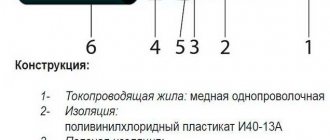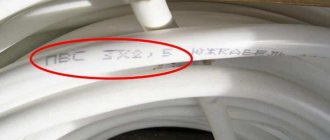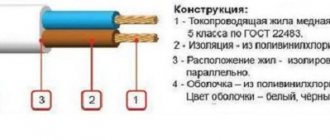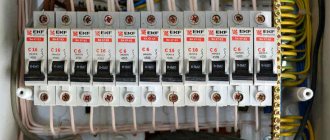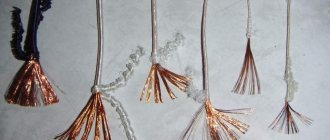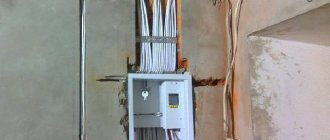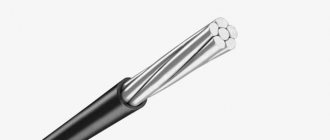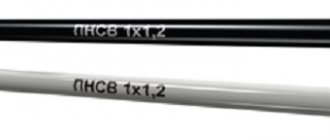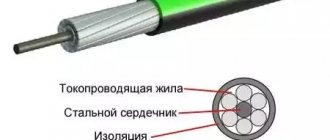Electrician in the house
Encyclopedia about electricity from A to Z
Masters catalog
Find the best master or company in your city
Wires PV3
PV3 wire is quite common and popular both among professionals and among people who are not very knowledgeable about electricity. In this regard, situations of improper use often occur, which leads to damage and sometimes fires.
That is why in our article we will consider all the features of this type of wire, its characteristics, as well as possible areas of application.
- Explanation and design of the PV3 wire Explanation of the abbreviation PVZ
- PV3 wire design
- Mechanical characteristics of PV3 wire
What is PV 3 wire
The PV 3 wire is a copper conductor, which is insulated with a layer of PVC (polyvinyl chloride).
This type of wire is used almost everywhere: connecting electrical mechanisms and devices, laying power networks and lighting networks. Its main difference from its predecessor PV 1 is that it is more flexible. PV 3 has more outstanding properties, which makes it capable of withstanding all kinds of bends and turns during laying without loss of quality. PV 1 is the least flexible of all conductors. The abbreviation is explained as follows:
- The letter "P" is the designation of the wire. There is, for example, “Sh” - cord or “K” - cable;
- The letter “B” is a determination of the presence of a certain type of insulation. In this case it is polyvinyl chloride, which is also simply called "vinyl". Hence the letter “B”;
- The number “3” indicates the flexibility class of the wire. As has already become clear, PV 1 is the most inflexible wire, while PV 6 is the most flexible. Three is somewhere in the middle.
Important! According to outdated standards, the name of any wire may be preceded by another letter, which should decipher what exactly the conductor’s veins are made of. For example, if there is the letter “A”, then it is aluminum, and if it is “M”, then it is copper.
Cord device
Suggested wire analogues
- VVG wire. This type of wire is applicable in both wet and dry areas. Poor stretchability. Its main variety is VVGng.
Image of an unarmored protective wire VVGng with protective conductors in a polyvinyl chloride sheath
The prefix “ng” means that in the event of a short circuit, fire will occur only on one conductor, without spreading to the entire cross-sectional area. Its advantages include:
- configuration variations;
- Various cross-section geometries.
Disadvantages: the design is not designed for excessive stretching. These types are produced by MARPOSADKABEL.
- Images of NYM electrical cable produced according to the German standard DIN 572250
NYM wire. Its distinctive feature is the use of German production standards.
The cable is used on high-rise structures, provided that it is not exposed to direct sunlight.
Consists of copper conductors and a non-flammable insulating sheath. Its advantages:
- flexibility;
- low degree of smoke emission;
- high fire hazard.
Disadvantages: cannot be used in the open sun. Cables of this type are produced by.
- Flat wire PUNP. The main feature is low cost compared to other models.
Image of a flat installation wire presented in the form of 3 cores with different colors.
Such conductors are used exclusively flat in light and power networks. This variety is offered with 2 or 3 copper cores. Often used for installing electrical wiring in domestic conditions. Advantages: used in open wiring.
Flaws:
- materials are not of high quality;
- instant loss of its properties when heated.
A large selection can be found in the online store “All Instruments.ru”
- Appearance of a single-core copper cable with PV insulation in different color variations
Single-core cable PV1. There are multi-wire and single-wire varieties.
Single-core cable is used in potential equalization systems. For installation in electrical panels, models with a large number of cores are used, which are more expensive varieties. Advantages: flexible shell for models with 2 or more cores.
Flaws:
- single-core cables are less flexible;
- multi-core cables are more expensive.
A large selection of PV-1 wires is offered at KabelTransService LLC.
Design elements of PV3 wires
Each cord or cable has certain design features. The type and number of elements are influenced by the purpose, operating conditions, and maximum voltage level. The structural details of the PV 3 installation wire are:
- copper core (according to GOST No. 22483 can be solid or multi-wire);
- external protection (insulating layer).
Explanation of the name of the wire PV-3
Despite the minimal number of elements, the wire has high technical characteristics, thanks to which it is used in various fields. For example, the PV 3 grounding cable is used in residential buildings and electrical devices.
Design
Structurally, the wire consists of the following elements:
- current-carrying conductors made of copper;
- insulating polyvinyl chloride coating.
Cable design
The wire can be single- or multi-core. The cores consist of solid or several twisted copper wires. Multicore cables consist of several insulated single cores twisted together.
Specifications
All characteristics of PV3 can be conditionally divided into mechanical, thermal and electrical, which determine its ability to fully solve the assigned tasks. Check them all out:
- Permissible wire bending radius – determines by what amount, depending on the parameters of the brand, a given conductor can be bent. This parameter is checked immediately after production and entered into the product passport. For PV3, the radius ratio is observed when laying at least 5 diameters of the outer part of the wire itself.
Rice. 4: bend radius - Permissible mechanical elongation of insulation - characterizes the ability of the polyvinyl chloride layer to change its geometric parameters, but not less than 50% of the existing length. So that the wire can be easily bent within a given range.
- Operating temperature is the permissible temperature limit at which normal operation of the wire is allowed without loss of its declared parameters. In relation to this brand, the nominal limits range from – 50°C to +70°C.
- Short-term overheating - exposure is allowed in an emergency or when the system is overloaded up to 150°C. At the same time, the insulation maintains dielectric and mechanical parameters.
- Resistance of the insulating layer to single impacts , acoustic and vibration influences. Due to its narrow specialization, such characteristics of PV3 are not relevant for the average consumer; they are important for communication lines and specific equipment.
- Electrical insulation resistance is tested at the manufacturing stage by immersing the wire in water and then applying a voltage of 2.5 kV for 5 minutes.
- Conductivity of the core is determined by the resistance of the copper conductor; this value is standardized for each brand separately and can vary depending on the temperature of the wire.
Table: dependence of PV-3 parameters on the number of wires and their cross-section.
| Nominal cross-section (mm2) | Minimum number of wires in the core (pcs) | Wire outer diameter (mm) | Maximum electrical resistance of the core at direct current and temperature 20°C. (MOhm/km) |
| 0,5 | 7 | 2,0 | 39,6 |
| 0,75 | 7 | 2,2 | 25,5 |
| 1,0 | 7 | 2,3 | 21,8 |
| 1,5 | 7 | 2,8 | 14,0 |
| 2,0 | 15 | 3,1 | 9,97 |
| 2,5 | 19 | 3,5 | 8,05 |
| 4,0 | 19 | 4 | 4,89 |
| 6,0 | 19 | 4,6 | 3,11 |
| 10 | 49 | 6,3 | 2,0 |
| 16 | 49 | 7,5 | 1,21 |
| 25 | 77 | 9,9 | 0,809 |
| 35 | 105 | 10,9 | 0,551 |
| 50 | 144 | 13,3 | 0,394 |
| 70 | 210 | 15,5 | 0,277 |
| 95 | 285 | 17,6 | 0,203 |
| 120 | 360 | 19,5 | 0,162 |
| 150 | 444 | 21,2 | 0,129 |
| 185 | 555 | 23,8 | 0,104 |
| 240 | 760 | 27,1 | 0,0808 |
It should be noted that despite the lower operating temperature limit of – 50°C, it is allowed to lay the wire in conditions not lower than – 15°C, since the insulation becomes fragile and can be easily damaged when bent. If you need to lay PV3 in a cold climate below – 15°C, it needs to be additionally heated.
Comparative characteristics of PUV with other wires
In many respects, other wires are not inferior to the option under consideration, and some are even better according to the stated parameters. But in practice, sometimes it turns out differently, the PUNP wire, for example, has a large assortment of wire cross-sections, several cores 2,3 and even 5 in double insulation, at first glance it is more practical to use it. It turns out that many parameters of PUNP do not correspond to the declared characteristics:
- Smaller wire cross-section;
- Wire alloy composition, reduced percentage of copper;
- The composition of the insulating layer must be made of non-combustible materials;
- The thickness of the insulation layer can be reduced to 20%.
This is due to the unscrupulous attitude of many manufacturers of the PUNP brand; at first, there was a very high demand for it. According to the stated characteristics, the product is good, but as statistics show, now 80% of the products on the market do not meet them; they have spoiled the product in the pursuit of profit.
Mechanical properties
Determine the scope of application and operating conditions:
- Flexibility. A remarkable property that increases operational value and efficiency of use. The cross-section of each wire is the same, the number in the set determines the degree of flexibility. According to GOST 22483-77 for PV 3 wire, the wire diameter is 0.79 mm. For small cross-section cables, the wire diameter can be 0.53 mm and the minimum number of cores is 7, which corresponds to the fourth class of flexibility. The sum of the cut areas of the cores is the nominal cross-section of the cable, indicated in the technical specifications. The permissible bending radius is at least five outer diameters;
- Strength. The concept of the conductor design in the form of a cable provides, in addition to flexibility, increased mechanical strength and increases the ability to bear loads. The insulation material, which can be two-layer, can successfully withstand various mechanical influences without loss of useful properties and destruction. Linear tension until the moment of failure is 150% of the original length, that is, it lengthens one and a half times. The thickness of the insulation depends on the diameter of the core;
Nominal core cross-section, mmNominal insulation thickness, mm
| From 0.5 to 1.0 incl. | 0.6 |
| 1.5 | 0.7 |
| from 2.5 to 6 | 0.8 |
| 10.0 and 16.0 | 1.0 |
| 25.0 and 35.0 | 1.2 |
| 50.0 and 70.0 | 1.4 |
| 95.0 and 120.0 | 1.6 |
| 150 | 1.8 |
| 185 | 2.0 |
| 240 | 2.2 |
- Colors. Using the right color is very important and must comply with generally accepted standards. Creates convenience, reduces labor costs for dialing, troubleshooting for installers and repairmen, and promotes the creation of safe conditions for handling electricity. The colors are determined by the PUE and the European standard: o Yellow-green, yellow or green - intended for connection to the ground contact, the international designation of the contact is “PE”; o Blue or cyan connects the neutral, or “zero” (“N”); o The remaining colors are designated by “phase” (“L”) and are chosen arbitrarily.
In three-phase versions, it is customary to mark the phases:
- A – white;
- B – black;
- C – red.
DC circuits use different markings. Here white, black is “plus”, red is always, the rest are, as necessary, “minus”;
- Temperature. High electrical safety indicators are ensured by the presence of two layers of elastic insulation made of polyvinyl chloride modifier. Allows flawless operation in the ambient temperature range -50⁰С - +35⁰С, allowing long-term operation when the core is heated to +70⁰С. Installation, to prevent the formation of shell cracks, is prohibited when the air is cooled below -15⁰С.
What does marking mean?
PV-3 wires of different sections
The cable is used in different situations - installation of electrical wiring, instruments, devices. There are different types and types of wires, the characteristics of which are indicated on the outside (on the “rubber” part). Symbols - letters, numbers, signs - allow you to determine:
- the number of cores inside and their material;
- insulating type;
- cross-section - cross-sectional area of the element - from 3.5 to 24 cm square;
- permissible voltage - nominal values of electrical indicators;
- attitude to environmental influences - humidity, heat;
- features of the internal design;
- flexibility - usually marked with numbers from 1 to 6, PV3 wire has an average rating.
Design features are also reflected in the markings. For example, the solidity or multi-wire nature of the internal element, the presence of insulation. Additionally, the type is indicated - wire, cable or cord.
Marking designation
Let's start with deciphering the abbreviation. Questions may arise due to the additional numbers that are added after the two main capital letters. Let's get started:
- The letter “P” in the first place indicates that the product is a wire. In addition to wires, these products are divided into two categories - cords (W) and cables (C).
- The letter "B" in second place indicates the type of insulation used. In this case we are talking about a polyvinyl chloride shell, the positive quality of which is its resistance to many physical and chemical influences. This is one of the main materials used as a dielectric.
- The last digit indicates the cable flexibility class - from “1” to “5”. The higher this value, the more flexible the product will be.
Wires are divided into two main categories - installation and installation. The first category includes products that can be used for a long period of time in the same place. We are talking, for example, about installing a socket, switch, etc. The installation wire is intended for repeated use and temporary connection of various equipment.
It is logical that a more flexible cable should be called an installation cable, while a more rigid product should be called an installation cable. For example, PV1 is an installation wire, which is not recommended to be constantly moved and used in different places, PV3 is an installation wire.
This is interesting: Protection device for LED lamps - which one to choose
Mark dimensions of wire PV3
- PV3 0.5
- PV3 0.75
- PV3 1.0
- PV3 1.2
- PV3 1.5
- PV3 2.0
- PV3 2.5
- PV3 3.0
- PV3 4.0
- PV3 5.0
- PV3 6.0
- PV3 8.0
- PV3 10
- PV3 16
- PV3 25
- PV3 35
- PV3 50
- PV3 70
- PV3 95
- PV3 120 *
- PV3 150 *
- PV3 185 *
- PV3 240 *
- PV3 300 *
- PV3 400 *
* Mark dimensions are not provided for in regulatory documentation.
Conditions for storage and transportation of PUV wires
In factories, wires are wound into coils or onto wooden drums; the coils can have different lengths and weights, this depends on the cross-section of the wire, the norms determined by the standards and the manufacturers:
| Designation of conduits Ø mm2 | Length, in industrial spools km. | |
| PV - 1 | 0,75 | 1,2 |
| 1,00 | 1 | |
| 1,50 | 08 | |
| 2,50 | 05 | |
| 4,00 | 04 | |
| 6,00 | 03 | |
| PV - 1 | 10,00 | 02 |
Length of PV (PUV) wire in meters for various drum designs:
| Operating voltage 0.66 kV | One core and cross-section in mm2 | External Ø of drum structure mm | ||||
| Brand | 800mm | 1000mm | 1200mm | 1400mm | 1600mm | |
| PUV | 1x10 | 3200m | 7300m | 14500m | 22400m | 36600m |
| 1x16 | 2000m | 4400m | 8800m | 13700m | 22400m | |
| 1x25 | 1200m | 2800m | 5600m | 8700m | 14200m | |
| 1x35 | 1000m | 2200m | 4400m | 6800m | 11100m | |
| 1x50 | 700m | 1600m | 3150m | 4900m | 8000m | |
| 1x70 | 500m | 1100m | 2300m | 3600m | 5900m | |
| PUV | 1x95 | 300m | 800m | 1600m | 2600m | 4200m |
Packing wires with a thick section on the structure of wooden drums is associated with the large weight of the wire, a coil of which requires a rigid, more durable structure. This makes it more convenient to transport and unwind wires at work sites.
Electrical parameters
The basic values of quality characteristics sufficient for practical use are the electrical insulation strength and the resistance of the conductive copper core, standardized by GOST to one kilometer of length. The values are presented in the table.
Number of cores X cross-section, mm 2 External diameter (size), mm. Wire weight, kg/km. Diameter of the conductor, mm. Maximum electrical resistance to direct current of the conductor (at +20°C), Ohm/km. Electrical resistance of wire insulation, kOhm/km, not less (at +70°C)
| 1×0,75 | 2.31 | 11.4 | 1.11 | 24.5 | 11 |
| 1×1,0 | 2.46 | 13.8 | 1.26 | 18.1 | 10 |
| 1×1,5 | 2.96 | 20.6 | 1.56 | 12.1 | 10 |
| 1×2,5 | 3.7 | 34.3 | 2.1 | 7.41 | 9 |
| 1×4,0 | 4.2 | 49.4 | 2.6 | 4.61 | 7 |
| 1×6,0 | 4.8 | 70.6 | 3.2 | 3.08 | 6 |
| 1×10,0 | 6 | 110 | 4 | 1.83 | 5.6 |
| 1×16,0 | 7.8 | 184 | 5.8 | 1.21 | 4.6 |
| 1×25,0 | 9.6 | 285 | 7.2 | 0.809 | 4.4 |
| 1×35,0 | 11.4 | 401 | 9 | 0.551 | 3.8 |
It can be seen that with an increase in the nominal cross-section, the maximum current resistance decreases, the permissible current load and the maximum connected load power increase. The physics of operation of alternating current circuits is manifested by mutual interference of the electromagnetic field. It is important to consider the number of wires in a joint installation. The table illustrates this. PV 1, shown in the table, differs from PV 3 in the presence of a single solid core rather than a twisted one, that is, only flexibility.
The electrical strength of PV 3 is guaranteed to allow successful operation in alternating current (frequency up to 400 Hz) and direct current networks up to 1000 volts inclusive. Insulation testing is carried out with an increased voltage of 2500V.
The section ends with a summary table of the main technical characteristics of PV 3. The data given in it is sufficient for practical use:
| Air humidity at 35 0 C [%] | 100 |
| Warranty period [month] | 24 |
| Test AC voltage 50 Hz for 15 min. After staying in water for 24 hours [B] | 2500 |
| Maximum operating temperature of the core [0 C] | 70 |
| Rated voltage U0/U [V] | -15 |
| Bending radius of cables [outer diameters] | 450/750 |
| Construction length, not less [m] | 10 |
| Ambient temperature, upper limit [0C] | 100 |
| Ambient temperature, lower limit [0 C] | +35 |
| Electrical insulation resistance, not less than [Mom*km] | -50 |
| 1.0 |
Positive qualities, features
PV 3 has undoubted advantages, expressed in the efficiency of the design and the materials used in its manufacture. This:
- A sufficiently large selection of the cross-section of the current-carrying conductor, correspondingly wide limits for connecting power;
- High flexibility provided by the design and materials used. Significantly facilitates the work;
- The insulation material contains substances that make wire products “unpalatable” to rodents and repel them. Limits the harm of exposure to mold and mildew;
- The use of special plastic modifiers in some brands of wire makes it possible to obtain products that do not support combustion when laid alone, self-extinguishing or with insignificant smoke emission;
- The ability of insulation does not deteriorate during long-term heating (+70⁰С) makes it possible to use PV 3 for heating pipes by winding around them, passing a sufficiently large one;
- The ability to operate at 100% ambient humidity at a sufficiently high temperature makes it possible to use it in the lighting network of baths and saunas, and to use it in the electrical systems of ships;
- Durability - almost 15-20 years, lack of contact with aggressive environments increases service life.
Scope of application
The scope of application of PV-3, on the one hand, is quite broad, but on the other hand, it is very narrow. The whole point is that it is a single wire. It can, according to GOST, be used for electrical wiring, lighting, connecting various installations inside both residential and non-residential premises, but it is more convenient to carry out power installation with cables with two or more conductive cores - for single-phase and three-phase connections, respectively.
Therefore, at present, one of the main tasks of PV-3 (PuGV) is the grounding connection, where a single conductor is required. In some cases, they may connect the neutral. A bundle of several wires of different colors can be used instead of a common cable where flexibility is primarily required. It is also often used in the assembly of power cabinets, for connecting automatic machines, contactors and RCDs, in industry - where for some reason single conductors are required. In this case, the wire must be connected only using a crimp lug - pointed or in the form of a loop, since otherwise the wire may burn out.
It can also be used to create jumpers.
PV-3 has a voltage limitation - 450 V for alternating current or 1000 V for direct current. To connect powerful consumers, it is recommended to use it with caution, carefully selecting the appropriate cross-section.
When used, the cable must be placed in a corrugated pipe, cable duct or armored sheath. Laying in the ground or embedding into a wall is not allowed, since during excavation or repair and construction work it can easily be damaged or even cut down. The protective sheath of this type of conductor is designed to resist only minor mechanical stress.
Open installation with staples is permitted as a temporary measure, but nothing more. It is not used outdoors, including the pulling method. Firstly, it is not self-supporting, and secondly, polyvinyl chloride gradually decomposes under the influence of direct sunlight.
If you have additional equipment, the wire can be used as a heating element - for heating frozen water pipes, and the like.
Its main advantage is lightness and flexibility. The minimum bend radius is 10 outer diameters, or exactly 90 degrees.
Note: modern PuGV has a higher flexibility class than its ancestor PV-3 - fifth.
This type of wire is moderately resistant to fire. When laid alone, it does not support combustion; in case of a short circuit, it melts, but does not spread fire. However, PV-3 is not fire-resistant wire and cannot be used in areas of increased explosion and fire hazard.
Application area
Application of PV-3 in electrical wiring
On the one hand, the PV-3 cable has a wide range of operation and application, on the other hand, it cannot always be used. The wire is single-core, which significantly reduces the scope of application. For example, for electrical wiring, in most cases it is recommended to lay multi-core cords. According to GOST PV-3 is suitable for:
- electrical wiring, lighting;
- connecting electrical devices and installations in residential and non-residential premises.
The cable is not a power cable, therefore it is not suitable for the same types of installation, two and three-phase connections. Here you need a cable with two and three cores, respectively.
The main purpose of the PuGV cable is grounding, where a single-core wire is sufficient. If the main cable requires additional flexibility, you can use several PV-3 wires twisted together. In rare cases, soft cords are connected to power cabinets and automatic machines in production.
Installation and operation
The PV 3 (PUGV) cable, due to its good flexibility, can be laid in any conditions. Vinyl coating is flame retardant. One of the advantages of PUGV is its immunity to destructive fungi and mold formations.
The installation wire PV 3 for installation in conditions where the ambient temperature is below -150C must be warmed up. This is done using various heating equipment. If this is not done, the “frozen” PVC shell may crack, especially at the bends. As a result, the insulation will be broken and the conductor will become unusable.
According to the installation technology, the PV 3 installation wire must be installed inside equipment that is well protected from high levels of humidity and condensation accumulation. PUGV is placed in cable ducts, boxes, sleeves and inside other protective devices. The practice of laying cables in the voids of reinforced concrete structures is also known.
Operation of PV 3 wiring is allowed in the ambient temperature range from -500C to +500C. The selection of the cross-section of the cores and the strength of the flowing current should not allow the conductor to heat above +700C.
Advantages and disadvantages of PV 3 wire
Like any conductor, PV 3 has its pros and cons. Positive sides:
- The conductor has an average level of flexibility, which is quite enough to solve many installation problems where PV 1 and PV 2 would perform poorly.
- Excellent resistance to external factors due to the insulating layer and polyvinyl chloride. A wire with undamaged insulation is not susceptible to water, moisture, mold or temperature changes.
- The presence of fire retardants in the insulation - special substances that extinguish themselves. If a wire catches fire due to a fire, its insulation will not begin to burn and will prevent the flame from spreading.
- Low cost. PV 3 wire is quite cheap compared to its analogues, which makes it even more attractive in the cable and wire products market.
- The guide is not afraid of rodents. This is possible due to the fact that the insulation is impregnated with a special substance that repels insects and mice.
Wires PV-3, PV-1, PuGV
Among the disadvantages of the wire, the following stand out:
- One layer of insulating coating.
- Mechanical memory of the core. If the cable has been lying twisted for a long time during use, it is not recommended to unbend it.
Storage of PV 3 in reels
Decoding
The abbreviation PV-3 means:
- P – wire;
- B – insulation is made of polyvinyl chloride material;
- 3 – corresponding flexibility class.
Dependence of flexibility on the number of wires
In order to facilitate the identification of cores during laying and making connections, their insulating coating is painted in solid colors or marked with colored stripes:
- blue – zero core;
- brown, indicating phase 1;
- black, marking the phase 2 core;
- gray, defining phase 3;
- yellow-green – grounding conductor;
- blue color is intended to indicate the middle conductor;
- red, white, purple and other common colors can characterize both the phase of the vein and other indicators.
Selection, nuances of choice
Before purchasing the wire necessary for the work, you need to calculate the required cross-section of the core taking into account the load. Careful calculation requires special knowledge and the ability to apply data from the tables “Rules for the construction of electrical installations” (PUE). For a non-professional, it is enough to know that a lighting network in a room requires 1.0 - 1.5 mm² of copper wire cross-section. Connection of sockets – 1.5 – 2.5 mm², electric boilers, stoves and air conditioners – 4.0. The entrance to a standard apartment is made with a cross-section of 6.0 mm². Having decided on the layout and wiring route for the facility, the total length of the wire of each required cross-section is calculated. A margin of size is needed, but the price range greatly depends on the diameter of the wire, so you should not include 6.0 mm² in the layout where 1.5 is enough.
Having completed the calculations, you need to start purchasing materials. The characteristics of the PV 3 wire comply with the requirements of GOST 6323-79, which standardize the material, the nominal cross-section of the core, and the thickness of the insulation. If there is no permanent, trustworthy supplier, the wire will be purchased randomly, wherever necessary. To protect your purchase from an dishonest seller, without trusting the markings, having a caliper is enough. The conductor diameter and insulation thickness are known from the technical specifications.
Important:
- Insulation. It can be single or double layer, in which case the first makes up at least 70% of the total thickness. The plastic should separate from the conductor easily enough without causing visible damage to the copper surface. The presence of dents, swellings and other irregularities is unacceptable.
- Lived. A fresh cut of the core will help you see the “correctness” of the material; you can find copper-plated aluminum at the price of copper. Irregularities, dark spots, non-copper color of the cut are a sign of poor quality copper. Real copper does not spring back when bent and can withstand at least 30 bends (high-quality aluminum will break after 8-10 times).
Check upon purchase
It is recommended to check the PV-3 cable very carefully before purchasing, since the market is flooded with a large number of fakes, characterized at best by an undersized cross-section, and at worst by a complete non-compliance with the stated requirements, primarily in terms of safety.
- It is always recommended to take products that are labeled with the wording GOST, and not TU. A cable made according to specifications is not formally considered a fake, but the fact is that each manufacturer determines the “technical conditions” for himself.
- A label should always be stuck on the bay, and alphanumeric markings should be applied to the insulation in a certain increment (about half a meter).
- Check the cross-section with a caliper you take with you.
- Request from the seller documents that the wire has passed the conductor resistance test, the insulation breakdown test, and the voltage test.
In addition, periodically during operation the cable must undergo “running tests”.
GOST and design differences
The difference between single-core and stranded wire
The last part of the marking indicates the recommended temperature level for operation and the number of technical documentation - GOSTs or TU. The latter contain information about methods and techniques for making wires. Manufacturers are required to indicate the GOST and TU numbers, but in recent years they have “forgot” to do this because they rarely adhere to the recommended parameters.
The installation wire PV 3 is single-core, multi-wire. Material: copper. Thanks to these characteristics, the cable conducts electricity well, bends easily in different directions, and does not deform. The marking is deciphered as follows:
- P – means “wire” type;
- B – insulation option, in this case polyvinyl chloride;
- 3 – flexibility class.
Technical characteristics allow the use of the PV-3 cable in various conditions and devices, including those with high humidity.
Errors when using PV-3 cable
Minimum requirements for core cross-section
If the PV-3 wire is laid independently, some features and common mistakes should be taken into account. First of all, it is necessary to check the compliance of the cross-sections of the internal core and the solid cable. If the diameter is smaller, overloads and burnout cannot be avoided.
Do not allow the internal wires to come into contact. More often this happens when connecting two-key and three-key switches. In this case, there will be a simultaneous short circuit of two networks, and consequently – an interruption in operation, a lack of voltage, or a fire.
Soft single-core cable PV-3 is used in various conditions. The range of cross-sections and voltage levels allows for installation by external and internal methods. For complex systems, multi-core wires are used.
Cable selection instructions
Comparison of two types of wiring made of aluminum and copper
To select a wire for the network, you need to decide on several parameters - cross-section, material, brand. The most common materials are copper and aluminum. Copper has better conductivity and is also non-corrosive. Aluminum is a soft material; cables bend quickly and break quickly. When aluminum comes into contact with air, it quickly oxidizes and an oxide film forms on the surface. Such a film does not transmit current signals well and provides unreliable contact.
The defining parameter of the section is diameter (d). At low current values, a copper core is used with a diameter of more than 1 mm2, and an aluminum core - 2 mm2. When working with large current values, the diameter is selected based on the power of the network. The diameter is selected according to table. 3, taking into account the cable laying through a pipe or openly.
Main manufacturers
When purchasing cable and wire products, it is important to obtain specified parameters that can ensure the nominal operating conditions of the system. Otherwise, you may encounter the problem of insufficient cross-section or inappropriate climatic design, when the connected wire or cable begins to overheat and lead to a line burnout. Therefore, it is so important to purchase PV3 only from trusted manufacturers. Among the well-established factories, the following should be highlighted:
- TD Alliance Cable;
- Special cable;
- Moskabelmet;
- Interregional trade and industrial company.
If you are just going to buy PV3 wire, pay attention to the products of the above-mentioned factories. If you already have a brand of PV3 wire from some other manufacturer, and you want to use it in electrical work, it is better to check its cross-section and the quality of the insulation.
What are the problems when using
During operation, the wire often breaks. This may occur due to improper installation. Other problems are short circuits, power surges, which can be caused due to atmospheric phenomena.
You might be interested in Homemade heating cable
Are there any problems when using the wire?
Note! To avoid this problem, experts recommend using aluminum material for cable insulation, since the tape has good adhesion to the conductor materials.

